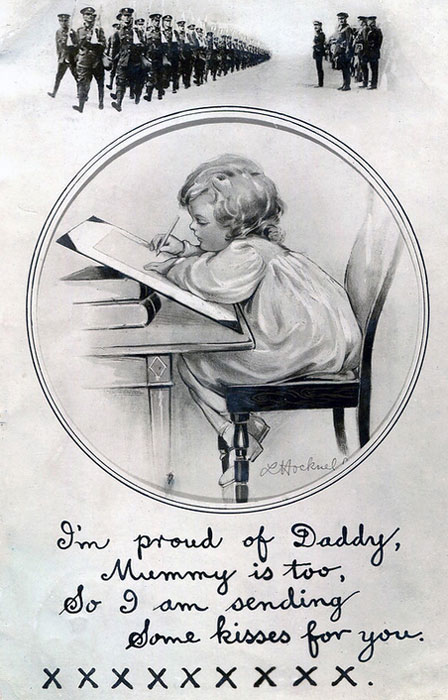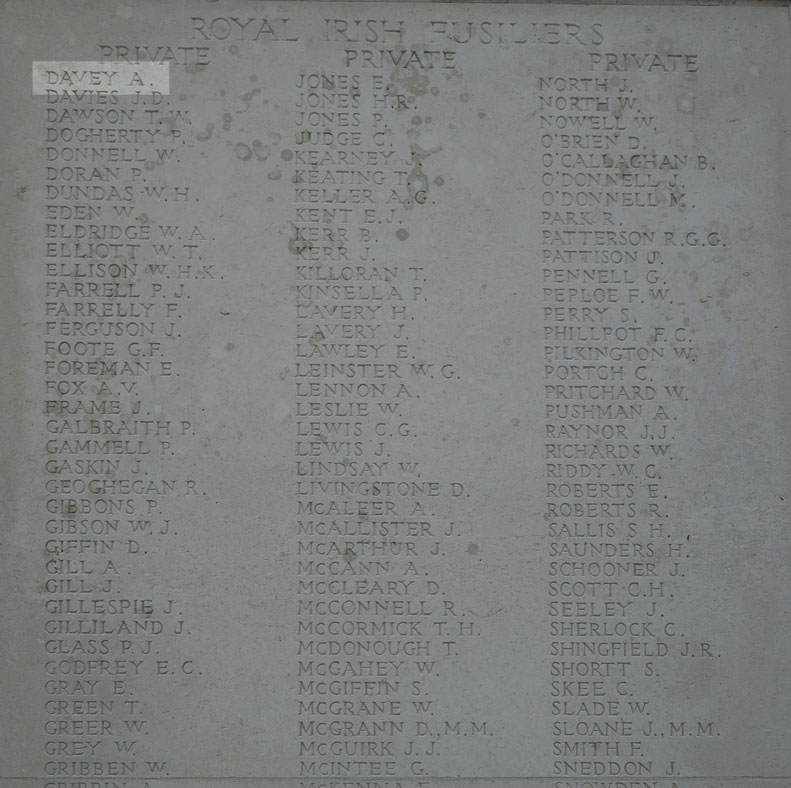![]() In memoriam
In memoriam ![]()
Private Allen Davey
Allen Davey was born on 31 January 1888 at Loughmourne, Carrickfergus, County Antrim, the first of eleven children of farmer William John Davey and his wife Maggie Isabella (nee Allen). By 1912 he was living in North Street, Carrickfergus and working as an insurance agent.
On 10 April 1912 he married Sarah Elliott Patterson at St Nicholas Church, Carrickfergus. The couple had three children in the next three years – Sarah Elizabeth, George Allen and William John.
Davey enlisted in the North Irish Horse at Belfast between 14 and 16 October 1914 (No.1312). He embarked for France on 1 May 1915 as part of D Squadron, which was serving as divisional cavalry to the 51st Division. Later that year or in early 1916 he was posted to C Squadron, which was serving as divisional cavalry to the 3rd Division.
At around this time he received the postcard below from his daughter and wife. It reads:
Dear Dad
Received your P.C. to-day sorry to hear you are gone up the line again. Lilla is being a good girl but daddy is a queer long time coming. With fondest love from Lilla & Mummy.
xxxxxxxxxX
Did you not get the baccy before you moved. I suppose not.


In June 1916 C Squadron combined with F Squadron and the 6th (Inniskilling) Dragoons Service Squadron to form the 2nd North Irish Horse Regiment, serving as corps cavalry to X Corps. In August-September 1917 the 2nd NIH Regiment was disbanded and its men, together with some surplus to the needs of the 1st NIH Regiment, were transferred to the Royal Irish Fusiliers, an infantry regiment.
Davey was one of 70 men given the job of conducting the regiment's horses to Egypt, to be handed over for use by mounted units there. They embarked from Marseilles on board HMT Bohemian on 25 August. After a month at Alexandria they returned to France, via Italy. On 5 October 1917 they arrived at the 36th (Ulster) Division Infantry Base Depot at Harfleur for infantry training, and after just a few days were posted to the 9th (Service) Battalion, Royal Irish Fusiliers – which had been renamed the 9th (North Irish Horse) Battalion – joining it in the field at Ruyaulcourt on 12 October. Davey was issued regimental number 41589.
It is probable that Davey saw action with his new battalion in the Battle of Cambrai in November and December 1917 and perhaps also in the retreat from St Quentin from 21 to 28 March 1918 during the German spring offensive.
On 9 April 1918 the 9th Battalion was on the Ypres front when the Germans began their offensive in that sector. The battalion saw severe fighting between Wulverghem and Kemmel for more than a week and suffered many casualties. Davey was one of those killed, probably in the early morning of 18 April when a composite battalion of 400 men from the 9th and 1st Royal Irish Fusiliers, and 12th Royal Irish Rifles, were caught in an enemy bombardment while moving to positions on the western slopes of Mount Kemmel.
According to the battalion diary for that day:
2 am. Moved to Kemmel, as composite Bn with 1st R. Ir. Fus. cmd. by Lt. Col. Kelly. Heavy casualties, while moving into position, from enemy shelling. Capt. Despard wounded and died soon after.
... and the 108 Brigade diary:
Battalion moved to Kemmel Hill, but whilst halted near foot of N. slope was heavily shelled, losing Captain Despard killed ... and about 70 other casualties.
As he has no known grave, Private Davey is commemorated on the Tyne Cot Memorial, Panel 141, Belgium.

Images Copyright © Phillip Tardif with all rights reserved as set out in this Use of Material policy.
Postcard images sourced from The Army Children of the First World War project and Carrick Times.

